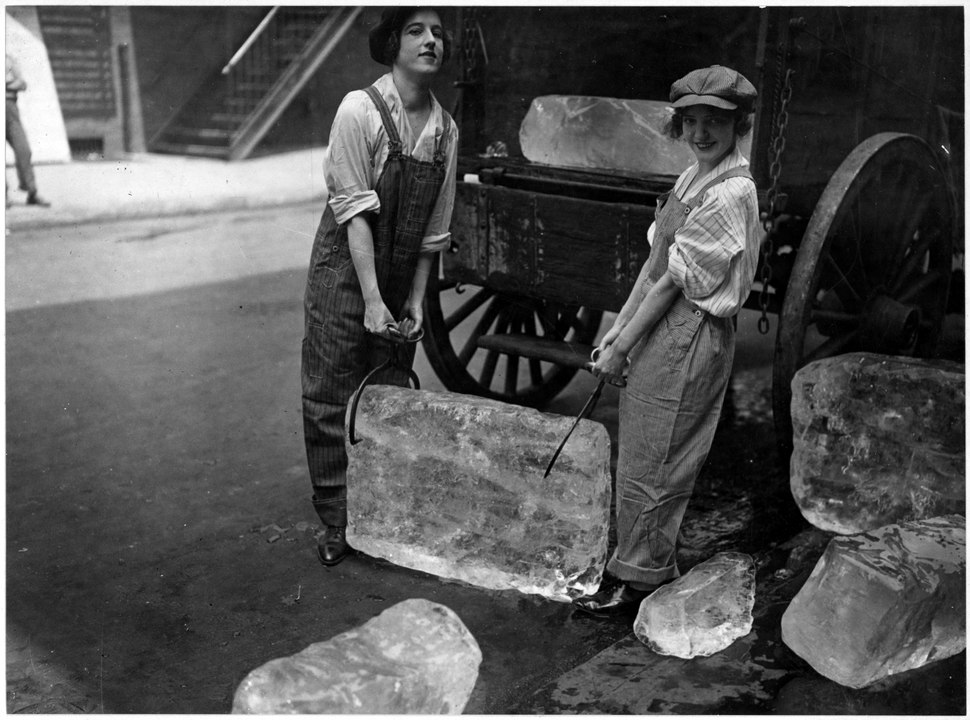
I learned this today. In the 1930s, the introduction of the refrigerator into homes put the ice harvesting industry out of business.
Any kind of food, be it meat, fish or vegetable, is going to start going bad. Food decays because micro-organisms like bacteria feed on the food. Bacteria use enzymes to break down the carbohydrates in the food and release waste products that can taste bad or be harmful. Bacteria need oxygen, water, and a suitable temperature to break down the food. To stop the food going bad, it is necessary to keep it at a low temperature. Before refrigerators, people have kept food cold in different ways.
The first hunter-gatherers would probably have not worried about keeping their food cold. What they didn’t eat straight away they would have dried to eat later. When agriculture arose and people could produce more than they could eat at once, it became necessary to preserve food. People would salt, pickle, or dry food. If they were available, streams and caves were also good places to keep food cold. The higher the stream and the deeper the cave, the colder they would be.
If people lived in a place where it got cold enough, they could keep their food cold with ice. The Mesopotamians discovered that keeping food cold kept it fresh for longer in about 2000 BC. They developed ice pits. Ice from the mountains would be cut and shipped to the city. Large amounts of ice would be placed in the ice pits and the amount of ice would keep the room temperature low enough to prevent it all melting. Water from the ice that did melt would coat the walls, lowering the temperature. The Persians built ice pits that they called yakhchal. They were dome shaped buildings made of clay.
In 3rd century Rome, there were snow shops where you could buy ice shipped down from the mountains. In China, ice houses were being used to keep food cold. But, the ice had to be shipped from the mountains, so it wasn’t cheap. Only the wealthy could make use of it. They sometimes used ice in their drinks as well. The Emperor Nero was fond of iced drinks, as were many other kings around the world.
And this was the way of things until over a thousand years later. By 1800, a lot of wealthy people had ice houses on their estates. Ice brought from the mountains would be kept in these ice houses and the wealthy people would be able to enjoy it whenever they wanted, but it was still expensive. In 1806, Frederic Tudor began to sell ice to the West Indies and southern American states. His business grew and he took advantage of a new horse-pulled ice cutter that had been invented. He had the ice wrapped in sawdust to stop it melting and he built ice depots in many cities to facilitate the storage. Because he could produce far more ice than had been possible before, the price started to fall. For the first time, regular people could now afford ice.
The railway network in America was increasing at this time and farmers started to purchase more of the cheaper ice so that they could chill their dairy and farm produce until it reached the market. This allowed them to ship farther than they had been able to before. It suddenly became possible to buy non-locally produced farm produce.
In the 1840s, a number of companies invented an icebox for the home. It would have a container to hold ice at the top, a section to hold frozen food in the middle, and a tray to catch the melted water at the bottom. The ice would be shipped from a local depot by horse and cart and the delivery man would load it into the icebox. These iceboxes took off. For the first time, people could buy and store frozen food. The ice industry helped globalization. Food could be shipped all over the world.
In 1855, an estimated 2 million tons of ice was kept in storage across America, with far more being in private hands. Ice was being cut and exported from Alaska and Norway, amongst other places. However, by the end of the century, businesses were turning away from natural ice because it was now possible to make ice by machine. The peak of the natural ice industry was in the 1890s with millions of tons of natural ice being shipped. By the early 1900s, ice made by refrigeration machines had taken the place of natural ice because it was cheaper. There were no international shipping costs involved.
The icebox continued to be used in most homes until 1930. Ice was made and shipped to houses, well into the 20th century. It was the popularization of the refrigerator that killed the ice industry. The refrigerator had been invented in 1834, but they were not safe to use and expensive. Iceboxes were too ingrained. In 1930, Freon gas was discovered, and the price of home refrigerators fell. And that was the end of the ice industry. It didn’t last five more years. Thousands of jobs were lost and most people these days don’t know there used to be an ice industry.
So, from the beginning of the 19th century, there was a market in shipping ice to be stored in ice houses. As more ice was shipped, the price came down and regular people could use it. Most people had an icebox in the house. It also allowed foods to be shipped internationally. The discovery of Freon gas in 1930 brought the price of home refrigerators down and they killed the ice industry. And this is what I learned today.
By International Film Service, Photographer (NARA record: 544230) – U.S. National Archives and Records Administration, Public Domain, https://commons.wikimedia.org/w/index.php?curid=16522514
Sources
https://www.materials.sandvik/en/campaigns/fridge-of-the-future/the-history-of-the-refrigerator/
https://www.livescience.com/57797-refrigerator-history.html
https://en.wikipedia.org/wiki/Refrigerator
https://en.wikipedia.org/wiki/Icebox
https://americanhistory.si.edu/blog/ice-harvesting-electric-refrigeration
